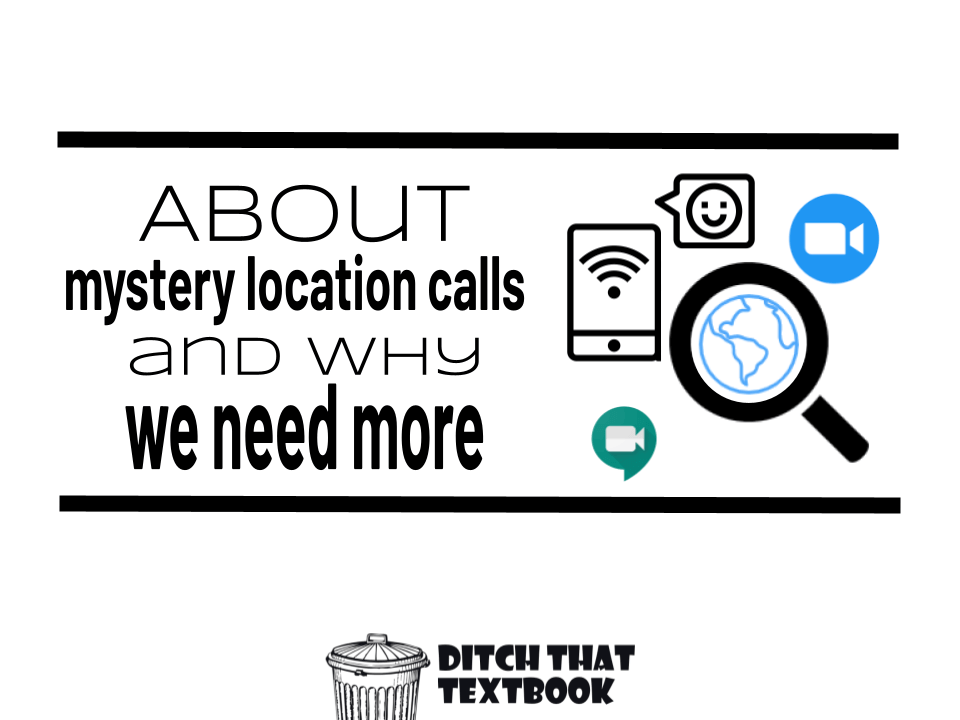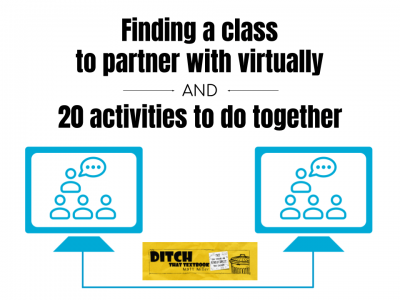Microsoft Teams is your classroom management hub if your students use Microsoft tools. Learn how to manage Teams like a ...



Mystery video calls can break down a classroom's walls and open students up to the world. They're easy to set up and can be transformational.
Picture it ... a sunny day in Valencia, Spain ... in a classroom.
My students from Indiana are engaged in a geography guessing game with these students from Spain, and they're enthralled.
The catch? My students were still in their classroom in Indiana. We weren't there physically ... but in some ways, it felt like we were.
It's called a mystery location call. You can do it, too ... quickly and easily.
You can run a mystery location call game, too ... using Zoom, Google Meet, or any video calling tool.
This kind of activity has great, great benefits -- but it doesn't appear to be used in the classroom enough, largely due to teacher anxiety and perceived lack of technical skills to do it. We'll talk about that more in a moment.
A mystery location call is a global guessing game between classes. They meet up in a video call and try to guess each other's location through a series of yes/no questions. It's like a mix of Twenty Questions and Battleship!
Connect with another class. It's easy to find a partner class to play a mystery video call game. Use the the Gridpals feature in Microsoft Flip to find an educator to connect with!
A mystery video call isn't limited to just geographic location! There are LOTS of variations of this game, including:
Video calls are a powerful tools that can bridge a gap of a thousand miles between schools. It can make conversations and activities happen that never could exist otherwise.
But if you're not careful, it can lead to missed opportunities. I’ve missed calls calls altogether. I’ve seen entire class periods squandered because of simple Internet connection miscues. But I’ve also seen the amazing learning that can be shared digitally.
So learn from my mistakes and the mistakes of others! Take these steps to ensure a smooth video call:
1. Schedule your call early and confirm it. Your calendar is your best friend here. Write the date down. Double-check it. Then check in with your partner teacher the day before (and maybe the day of) to make sure they remember. I’ve been the offending party on forgetting a video call. Trust me, you don’t want to feel like you’ve disappointed a teacher and a whole class of kids in a different part of the world.
2. Check and double check your time zones. Video calling with students in Spain was an awesome experience for my students. Remembering what time it was there could be tricky, though — especially when we changed our clocks for daylight saving time. I didn’t factor that in and almost missed out on the last call in a two-month video call project because of it.
3. Consider the configuration of students to devices. My students often felt anxiety about being in front of a whole class of teenagers they’d never met hundreds (or thousands) of miles away. So we used the six iPads in our class and worked with two or three students per device. The smaller groups were less intimidating and gave students a partner so they didn’t feel alone.
4. Make a plan for user names. For whole-class mystery video call activities, one class user name was great. When students split into small groups, I created a user name for each iPad in class and students shared. If students are doing one-on-one work with other students, individual user names would probably be best. Think about how students will use the video conferencing app accounts and make the best choice possible to manage them. It’s OK if you change your mind later, too.
5. Assign students to jobs. This is especially important with whole-class video calls and mystery video calls. Having a specific role in the process keeps students engaged and makes everything run more smoothly. During mystery video call, I adopted but modified Pernille Ripp’s list of student jobs based on my class’s Spanish-language questions. Number of students in each section is very flexible based on what kids want to do:
6. Hide the location. Some video conferencing tools display the location of your contacts when you view them. If you’re engaging in a mystery video call activity, be careful to guard your students from that so you don’t ruin the surprise. Some teachers choose to remove their location or make it very, very vague.
7. Check your video call connection (maybe twice). I suggest making a test call with your partner teaching more than a day before (to have time to fix potential problems or ask tech staff to help you) and the day of the call (to avoid last-second problems).
8. Be creative to make it happen. If a video call experience doesn’t look like it can happen at first, a little creative thinking can change that. I wanted my last class of the day to video call with our Spain partners, but it was past dinner time in Spain when our class met. We recorded video messages instead of using live calls to communicate. We wrote each other in shared Google Documents. And on one day, with permission from their teachers, I pulled students out of a morning class so we could have one live video call. It was worth it.
9. Be flexible and understanding with the other class. This is especially important with international calls. Their social norms, communication customs, sense of time and connection issues may be very different. Factors out of everyone’s control pop up, too. This was the worst winter for school-day delays and cancellations in 20+ years for us, and it altered my video call plans on a regular basis. I’m so thankful I’ve had very flexible and understanding teachers and classes in South Carolina, Florida, Canada and Spain to work with.
10. Talk to students about the experience. I like to have control and make all the plans, but that’s not always the best thing. I have to remember to keep my students in the loop. I ask them what they like about video calls, what they don’t like, what changes they suggest and what topics they want to discuss. Then I do my best to incorporate their ideas. They have to be dedicated to the process to make it worthwhile.
After lots of conversations at teacher conferences and professional development workshops, I've heard Zoom and Google Hangout mentioned as a valuable resource in many.
The thing that surprises me, though, is how few educators actually use video calls with students. I've reached out to educators via Twitter hashtags and through other channels in attempt to find class partners for mystery video call. The sparse results have surprised me a little.
I'm betting the lack of participation stems from three very common stumbling blocks in educational technology: anxiety, perceived lack of technical ability and lack of time.
ANXIETY: I'll lay the anxiety stumbling block to rest. I have participated in a lots of Zoom/Meets like the ones mentioned here, I'll bet that it will generally be a positive experience for everyone involved:
I've found that even if my new ideas flop, my students often are grateful for the effort to try something different. And with a little planning, they probably won't totally flop, and you may have something that could transform your teaching -- or your students' lives.
PERCEIVED LACK OF TECHNICAL ABILITY: Mystery video calls are really easy to set up, too. They mostly consist of connecting your webcam (if it isn't already embedded in your computer), adding the participating class's Zoom/Google Meet account and testing the connection. If the other teacher has done video chats before, he/she may be able to give you some guidance.
Plus, much like almost any app or site, there's very little you can do wrong to break it or mess it up. Jump in and give it a shot, and if you can't figure something out, there's always Google!
LACK OF TIME: This can be an excuse not to try anything. The truth is that we make time for what we want to make time for. I took a few minutes here and there over the course of a weekend to gather the information I needed about video chatting. If we want to make a difference in our students' lives and provide them opportunities to grow and experience new things, we make it happen.
Want to get started with a mystery video call? Here are some articles, blog posts and other resources that can get you going!
Are you interested in using video chats in class? Leave us a comment to say how you'd like to use it! Or if you've used Zoom or Google Hangout in class, please tell us how it went!

Microsoft Teams is your classroom management hub if your students use Microsoft tools. Learn how to manage Teams like a ...

When students are learning from home, Google Meet can be the connection you need with them. Here are ideas for ...

Chances are, you're already doing video calls in your personal life. Using them in the classroom is easier than you ...

Video calls and technology can bring experts in other countries and researchers in Antarctica to your classroom. Here’s how to ...

Video calls can get your students connected to others just like them around the country and world! Here's how to ...

Using video call tools like Zoom or Google Meet students can connect with people, places and experiences. Here are 20 ...
For notifications of new Ditch That Textbook content and helpful links:
Matt provides in-person and virtual keynotes, workshops and breakout sessions that equip, inspire and encourage teachers to create change in their classrooms. Teachers leave with loads of resources. They participate. They laugh. They see tech use and teaching in a new light. Click the link below to contact us and learn how you can bring Matt to your school or district!
Is Matt presenting near you soon? Check out his upcoming live events!

Session expired
Please log in again. The login page will open in a new tab. After logging in you can close it and return to this page.
[…] Read the full story by Ditch That Textbook […]
[…] Mystery Hangouts are particularly great for elementary grade levels. In a Mystery Hangout, your classroom will video chat with another classroom located in another region, state, or country. Using questioning skills and context clues, students must figure out where the other class is located. These are super fun! […]
[…] http://www.hippasus.com 2. “About Mystery Skypes/Hangouts and why we need more” Ditch That Textbook. Nov. 25, 2013. 3. “Bloom’s Taxonomy” Vanderbilt University’s Center […]
A mi me interesaría un #MysterySkype donde mis alumnos (segundo grado, 7-8 años de edad) hablen en inglés y los tuyos contesten en español, así ambos pueden practicar su segunda lengua, ¿te interesa? mi correo es sofia.velazquez@cap.edu.mx
[…] About Mystery Skypes/Hangouts and why we need more – https://ditchthattextbook.com/2013/11/25/about-mystery-skypeshangouts-and-why-we-need-more/ […]
[…] Mystery Hangout “is a social game played with two groups of students. It’s a mix of Battleship and 20 questions.” When you join the Google+ Community, you can propose a Mystery Hangout or connect with a teacher who has proposed a Mystery Hangout. More information on Mystery Hangouts is listed here. […]
[…] Mystery Hangout “is a social game played with two groups of students. It’s a mix of Battleship and 20 questions.” When you join the Google+ Community, you can propose a Mystery Hangout or connect with a teacher who has proposed a Mystery Hangout. More information on Mystery Hangouts is listed here. […]
[…] About Mystery Skype/Hangout and why we need them […]
Hello Matt,
Sending this piece to my administration. They could use the information themselves!
I have a class of 5th graders in Iowa. If you are looking for a Mystery Skype, let us know!
We are always up for the adventure!
Thanks for the article!
Gina
Thanks for including information about the Mystery Skype activity. I’m hoping to put this idea in action. Great article.
Thanks Paula … from the master global collaborator, that means a lot! 🙂